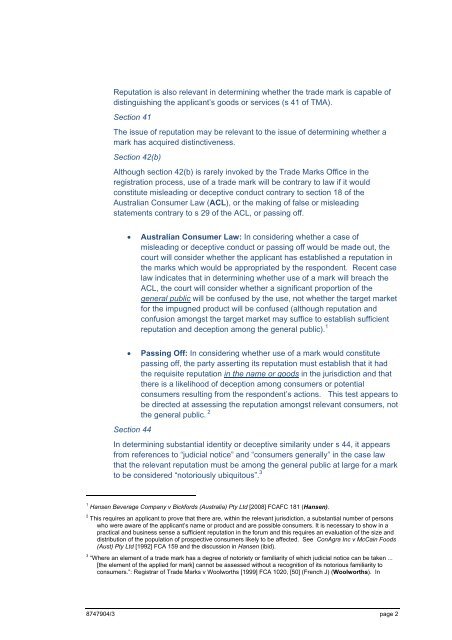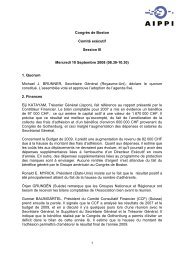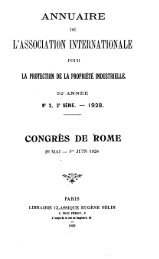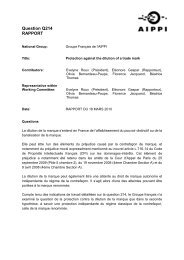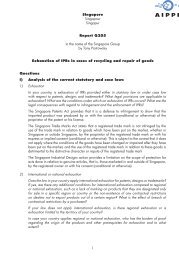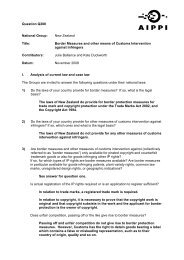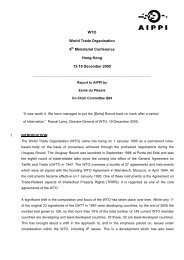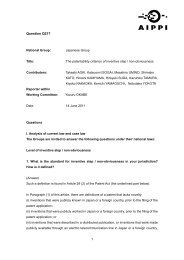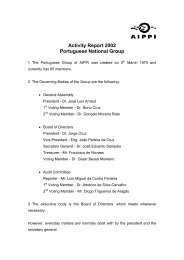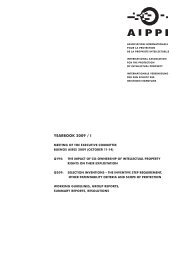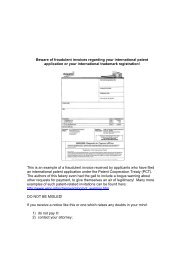Question Q234 National Group: Australia Title: Relevant ... - AIPPI
Question Q234 National Group: Australia Title: Relevant ... - AIPPI
Question Q234 National Group: Australia Title: Relevant ... - AIPPI
You also want an ePaper? Increase the reach of your titles
YUMPU automatically turns print PDFs into web optimized ePapers that Google loves.
Reputation is also relevant in determining whether the trade mark is capable of<br />
distinguishing the applicant’s goods or services (s 41 of TMA).<br />
Section 41<br />
The issue of reputation may be relevant to the issue of determining whether a<br />
mark has acquired distinctiveness.<br />
Section 42(b)<br />
Although section 42(b) is rarely invoked by the Trade Marks Office in the<br />
registration process, use of a trade mark will be contrary to law if it would<br />
constitute misleading or deceptive conduct contrary to section 18 of the<br />
<strong>Australia</strong>n Consumer Law (ACL), or the making of false or misleading<br />
statements contrary to s 29 of the ACL, or passing off.<br />
<br />
<strong>Australia</strong>n Consumer Law: In considering whether a case of<br />
misleading or deceptive conduct or passing off would be made out, the<br />
court will consider whether the applicant has established a reputation in<br />
the marks which would be appropriated by the respondent. Recent case<br />
law indicates that in determining whether use of a mark will breach the<br />
ACL, the court will consider whether a significant proportion of the<br />
general public will be confused by the use, not whether the target market<br />
for the impugned product will be confused (although reputation and<br />
confusion amongst the target market may suffice to establish sufficient<br />
reputation and deception among the general public). 1<br />
<br />
Section 44<br />
Passing Off: In considering whether use of a mark would constitute<br />
passing off, the party asserting its reputation must establish that it had<br />
the requisite reputation in the name or goods in the jurisdiction and that<br />
there is a likelihood of deception among consumers or potential<br />
consumers resulting from the respondent’s actions. This test appears to<br />
be directed at assessing the reputation amongst relevant consumers, not<br />
the general public. 2<br />
In determining substantial identity or deceptive similarity under s 44, it appears<br />
from references to “judicial notice” and “consumers generally” in the case law<br />
that the relevant reputation must be among the general public at large for a mark<br />
to be considered “notoriously ubiquitous”. 3<br />
1<br />
Hansen Beverage Company v Bickfords (<strong>Australia</strong>) Pty Ltd [2008] FCAFC 181 (Hansen).<br />
2<br />
This requires an applicant to prove that there are, within the relevant jurisdiction, a substantial number of persons<br />
who were aware of the applicant’s name or product and are possible consumers. It is necessary to show in a<br />
practical and business sense a sufficient reputation in the forum and this requires an evaluation of the size and<br />
distribution of the population of prospective consumers likely to be affected. See ConAgra Inc v McCain Foods<br />
(Aust) Pty Ltd [1992] FCA 159 and the discussion in Hansen (ibid).<br />
3<br />
“Where an element of a trade mark has a degree of notoriety or familiarity of which judicial notice can be taken ...<br />
[the element of the applied for mark] cannot be assessed without a recognition of its notorious familiarity to<br />
consumers.”: Registrar of Trade Marks v Woolworths [1999] FCA 1020, [50] (French J) (Woolworths). In<br />
8747904/3 page 2


